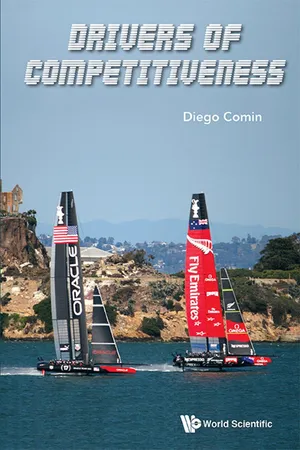
- 576 pages
- English
- ePUB (mobile friendly)
- Available on iOS & Android
Drivers of Competitiveness
About this book
In this day and age, technology has become ever more prominent and omnipresent in our lives. As technological developments emerge and become more ubiquitous, it becomes vital to understand and analyze the impact of technology on society.
Drivers of Competitiveness focuses on technology and seeks to analyze its causes and consequences on productivity and competitiveness and to examine the dynamic relationships between the different factors in various contexts. Building on state-of-the-art research, the book illustrates the global, institutional and technological factors that shape the performance of business and countries.
Unlike most existing books in the field, Drivers of Competitiveness is a self-contained case book ideal for classroom use. The cases in the book are brand new. All of them are written in the context of the global financial crisis, providing a new perspective on the crisis that sheds light on its effect on competitiveness and on the diversity of responses by companies and countries. The cases and the analytical framework that emerges from the book constitute an essential kit for current and future managers, policy-makers and observers of global dynamics.
Request Inspection Copy
In this day and age, technology has become ever more prominent and omnipresent in our lives. As technological developments emerge and become more ubiquitous, it becomes vital to understand and analyze the impact of technology on society.
Drivers of Competitiveness focuses on technology and seeks to analyze its causes and consequences on productivity and competitiveness and to examine the dynamic relationships between the different factors in various contexts. Building on state-of-the-art research, the book illustrates the global, institutional and technological factors that shape the performance of business and countries.
Unlike most existing books in the field, Drivers of Competitiveness is a self-contained case book ideal for classroom use. The cases in the book are brand new. All of them are written in the context of the global financial crisis, providing a new perspective on the crisis that sheds light on its effect on competitiveness and on the diversity of responses by companies and countries. The cases and the analytical framework that emerges from the book constitute an essential kit for current and future managers, policy-makers and observers of global dynamics.
Request Inspection Copy
Readership: International business; current and future managers, policy-makers and observers of global dynamics.
Key Features:
- Presents a new and original conceptual framework to explore the drivers of competitiveness and productivity
- Incorporates state-of-the-art research on the drivers and consequences of technology
- Based on new case studies, all written in the context of the recent global recession, providing a new perspective on the crisis and new managerial insights
Frequently asked questions
- Essential is ideal for learners and professionals who enjoy exploring a wide range of subjects. Access the Essential Library with 800,000+ trusted titles and best-sellers across business, personal growth, and the humanities. Includes unlimited reading time and Standard Read Aloud voice.
- Complete: Perfect for advanced learners and researchers needing full, unrestricted access. Unlock 1.4M+ books across hundreds of subjects, including academic and specialized titles. The Complete Plan also includes advanced features like Premium Read Aloud and Research Assistant.
Please note we cannot support devices running on iOS 13 and Android 7 or earlier. Learn more about using the app.
Information
Introduction
Synopses and Assignment Questions
Inkaterra
AQ:
ABB: “In China, for China”
AQ:
Low carbon, Indigenous Innovations in China
AQ:
CoET: Innovation in Africa
AQ:
Malaysia: Standing on a Single Leaf
AQ:
Fraunhofer: Innovation in Germany
Fraunhofer: Five Significant Innovations
AQ:
Table of contents
- Cover
- Halftitle
- Title
- Copyright
- Dedication
- Contents
- Acknowledgments
- Introduction
- I. Globalization
- II. Institutions
- III. Technology and Innovation
- Drivers of Competitiveness
- Epilogue
- Index